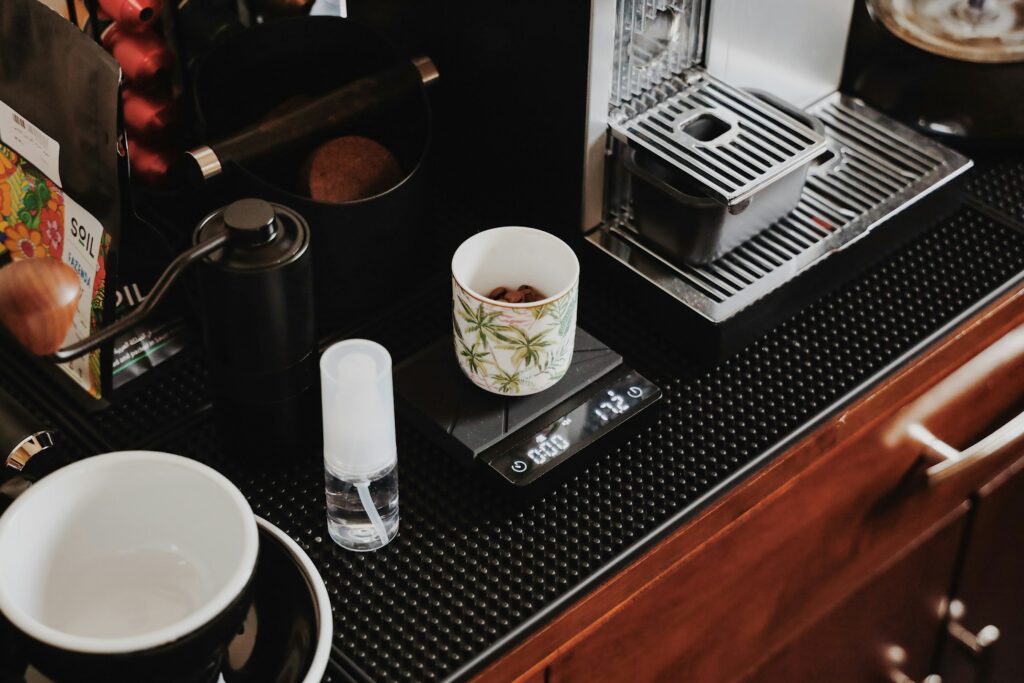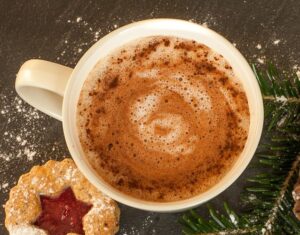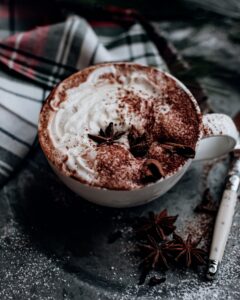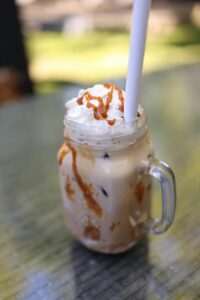A good coffee scale is like a lab instrument for your kitchen – it keeps your brew consistent no matter the method. Accurately weighing beans and water is the secret to repeatable, great coffee.
Unlike a regular kitchen scale, a coffee-specific scale has very fine precision (often down to 0.1 g) and a built-in timer. It will happily time your pour-over or espresso shot while you focus on pouring.
In short, a coffee scale makes every brew method (pour-over, French press, espresso, AeroPress, etc.) more reliable.
Most coffee recipes even specify a coffee-to-water ratio (like 1:16), so a scale ensures you hit that ratio every time.
However, not all scales handle all brew styles equally. Big platforms are great for Chemex or French press carafes, but they may not fit under your espresso machine’s portafilter.
Narrow espresso-friendly scales fit under the portafilter but might be too small for a large mug or brewer. As a rule of thumb, pick a scale designed for your main brew.
If you do both drip and espresso, consider two scales. In practice, a scale is your ally for any brewing method – just match its size and features to the way you brew.
Both Weight and Timer
A great coffee scale performs two jobs at once: it weighs with precision and times your brew. Most quality coffee scales have both functions built in.
Having a timer on the scale means you can keep an eye on extraction time without juggling a second stopwatch.
For instance, the tiny Weightman espresso scale (about $20) became a fan favorite because it packs a backlit display showing weight and a running timer side by side.
Reviewers note that the built-in timer is a rarity among portable coffee scales, and having both readings together makes dialing in espresso shots much easier.
Many mid- to high-end coffee scales go even further. Some offer a brew-assist or ratio mode. You enter your desired coffee-to-water ratio (say 1:16), and as you pour, the scale counts down to the target weight and signals when you’ve added enough water.
These scales often start their timer automatically when water hits the beans, so you don’t even have to press start when brewing.
In short, the “both” features (weight and timer) let a single device guide your entire brew. Look for:
- A clear, easy-to-read display
- Fast and accurate weight response
- A reliable timer function (preferably auto-start)
Best Scales by Price Range
Here’s a quick guide to some top-rated coffee scales at different budgets, with pros and cons for each.
Use this as a starting point – the best choice depends on how you brew, how much you want to spend, and which features matter most to you.
Best Budget (Under ~$30)
Weightman Espresso Scale (~$17)
A tiny powerhouse for the price. Slim enough to sit under most espresso portafilters, and includes a built-in timer.
- Pros: Extremely affordable; accurate and responsive; timer built-in; folds flat with a travel lid.
- Cons: Small surface area; basic plastic build; slight 1–2 g offset noted by some users.
Best Value ($30–$60)
OXO Brew Precision Scale (~$55–60)
A reliable, easy-to-use scale with a large platform for Chemex or French press.
- Pros: Affordable; simple design; big load capacity.
- Cons: Slower response than premium models; splash-proof only; no brew modes.
Hario V60 Drip Scale (~$43)
Designed for pour-over brewing, especially with Hario gear.
- Pros: Sturdy build; clear display; perfect for cones and carafes.
- Cons: Laggy weight response; too large for most espresso machines; not water-resistant.
Normcore Pocket Scale V3 (~$60)
Compact metal build with multiple modes and a timer.
- Pros: Durable aluminum body; fast response; versatile modes; built-in timer.
- Cons: Small surface; not suitable for large brews like Chemex.
Best Mid-Range ($60–$100)
Timemore Black Mirror Basic Pro (~$65)
Stylish with an auto-start timer and flow-rate mode.
- Pros: Sleek design; bright display; flow-rate indicator; USB-C rechargeable.
- Cons: Not waterproof; touch controls can trigger accidentally.
Hario Polaris (~$79)
Versatile enough for both espresso and pour-over.
- Pros: Compact yet roomy; auto-start timer; ratio mode; highly sensitive.
- Cons: Digits on display are small; measures only up to 2 kg.
Best Premium (>$100)
Acaia Pearl (~$160)
Professional-grade precision with app connectivity.
- Pros: Extremely precise; responsive; rechargeable; Bluetooth + app features; sleek design.
- Cons: Very expensive; relatively small platform; display could be larger.
Fellow Tally Pro (~$200)
Ultra-premium designer scale with Brew Assist mode.
- Pros: Gorgeous design; premium feel; lightning-fast response; Brew Assist for pour-over.
- Cons: No built-in timer; very expensive; glass top is fragile.
Coffee Scale Buyer’s Guide
Accuracy: The Heartbeat of a Good Scale
If your scale isn’t accurate, the rest doesn’t matter. You could be adding too much coffee or short-changing your water without even realizing it.
A small difference—say, one gram—can change the flavor in your cup. Look for a scale that measures in increments of at least 0.1 grams.
It sounds tiny, but it’s the difference between a smooth latte and a sad puddle of bitter regret.
Response Time: No One Likes Slow Friends
Ever pour water over your grounds, and the numbers take forever to catch up? That lag ruins your rhythm. A fast response time lets you stay in sync with your brewing.
It feels like dancing—when the music’s on beat, you’re smooth. When it’s late, you trip over your own feet. Test or read reviews to see how quickly a scale responds. Speed matters.
Built-In Timer: The Unsung Hero
Brewing coffee is part science, part art, and timing is everything. Having a built-in timer keeps your focus on the pour instead of juggling your phone.
You’ll nail consistency without stress. It’s one less thing cluttering your counter. Once you have it, you’ll wonder how you ever brewed without it.
Capacity: Know Your Needs
Not all scales are built for the same tasks. Brewing for one? A smaller capacity scale will do just fine.
Brewing for a crowd with a big Chemex? You’ll need something that can handle a larger carafe without maxing out.
Check the maximum weight limit before you buy. Better to be safe than to watch your scale buckle under pressure like a bad office chair.
Size and Design: Form Meets Function
A scale should fit your gear and your counter. Too big, and it hogs space. Too small, and your mug might cover the display.
Some have backlit screens that are easy to read, even when your kitchen lighting is dim and you’re still half asleep.
Pay attention to the build, too. A sleek design isn’t just pretty—it often means better usability.
Water Resistance: Because Spills Happen
Coffee brewing is a messy affair. Water splashes, coffee drips, accidents happen. A water-resistant scale is worth the extra dollars.
It saves you from the heartbreak of frying your brand-new gadget with one clumsy pour. Think of it like insurance: you may not need it often, but when you do, you’ll be thankful.
Battery Life and Power Options: The Long Game
Some scales run on AAA batteries, others on USB rechargeables. Either way, look for something reliable. Nothing is worse than your scale dying halfway through a pour-over.
Rechargeables are convenient, but batteries are quick to swap if you forget to charge. It really depends on your lifestyle.
Price vs. Value: Don’t Chase Bargains Blindly
Cheap doesn’t always mean cheerful. A bargain-bin scale might work at first, but fail after a month. On the flip side, you don’t need to drop a fortune.
Think of it like shoes: you want something sturdy enough for daily use without paying luxury-brand prices for glitter you’ll never notice. Strike a balance—durability and features should guide your choice.
Extra Features: Nice-to-Haves, Not Must-Haves
Some scales connect to apps, track your brews, or let you geek out with data. That’s great if you’re a detail lover. But for most people, accuracy, speed, and a timer are the essentials.
Don’t get dazzled by extras you won’t use. Focus on what helps you brew better coffee daily, not what looks cool in an Instagram post.
Final Sip
A good coffee scale doesn’t just sit on your counter; it becomes part of your morning ritual. Accuracy, speed, timer, and durability are non-negotiable. The rest depends on how fancy you want to get.
Think about your habits, your space, and your patience for tech. Get it right, and you’ll have a tool that makes every brew feel like a small victory.
General Recommendations
No matter which scale you pick, keep it level and protected from heat. Many come with silicone heat pads to shield sensors from hot carafes.
Always place the scale on a flat surface and calibrate it now and then with a known weight if possible. Clean spills quickly – coffee and water can be tough on electronics.
Be honest about your needs:
- Pour-over only? Go for a larger platform with brew modes.
- Espresso only? Choose a compact, fast-responding scale.
- Both? Either buy two specialized scales or pick a versatile hybrid option.
Finally, think of the scale as an investment in your daily ritual. Even a budget model will outperform guessing with scoops. With the right scale, you can brew consistently delicious coffee cup after cup.



